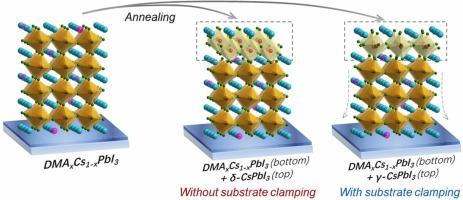DMAxCs1-xPbI3钙钛矿太阳能电池的相分布和相变动力学
IF 17.1
1区 材料科学
Q1 CHEMISTRY, PHYSICAL
引用次数: 0
摘要
黑相CsPbI3是一种无br的宽禁带钙钛矿,具有良好的光稳定性和热稳定性,在室温下倾向于转变为非钙钛矿黄色相,这对其在太阳能电池器件中的应用提出了重大挑战。为了解决这一问题,经常加入二甲基碘化铵(DMAI)形成黑色相DMAxCs1-xPbI3以适应容差因子,但其相行为及其对器件稳定性的影响尚不清楚。本文采用前后激光激发的瞬态反射光谱研究了DMAxCs1-xPbI3薄膜在热处理过程中的相变动力学和垂直相分布。我们的研究结果表明,这些性能受到衬底选择的影响。在长时间退火过程中,DMAI部分蒸发,引起晶格重组,导致表面降解。对于具有强夹紧效应的衬底,表面DMAxCs1-xPbI3转变为黑色相CsPbI3,而对于那些具有弱夹紧效应的衬底,它直接降解为黄色相。重要的是,DMAxCs1-xPbI3薄膜在靠近表面黑色CsPbI3相出现的边界处退火时表现出更好的稳定性,特别是当由具有合适热膨胀系数和与钙钛矿强配位的有机衬底支撑时。本文章由计算机程序翻译,如有差异,请以英文原文为准。

Manipulating phase distribution and transformation kinetics by substrate clamping for DMAxCs1-xPbI3 perovskite solar cells
The black-phase CsPbI3, a Br-free wide-bandgap perovskite with promising light and thermal stability, tends to transition to a non-perovskite yellow phase at room temperature, posing a significant challenge for its application in solar cell devices. To tackle this issue, dimethylammonium iodide (DMAI) is frequently included to form black phase DMAxCs1-xPbI3 to accommodate the tolerance factor, however, its phase behavior and effect on device stability are still not well understood. In this work, we employed transient reflection spectroscopy with front and back laser excitation to investigate the phase transformation kinetics and the vertical phase distribution of DMAxCs1-xPbI3 films during thermal annealing. Our results indicate that these properties are influenced by the choice of substrate. During prolonged annealing, DMAI partially evaporates, causing lattice reorganization and leading to surface degradation. For substrates with a strong clamping effect, the surface DMAxCs1-xPbI3 transitions to a black phase CsPbI3, whereas for those with a weak clamping effect, it degrades directly to the yellow phase. Importantly, films of DMAxCs1-xPbI3 exhibit improved stability when annealed close to the boundary where the black CsPbI3 phase emerges at the surface, particularly when supported by an organic substrate that has a suitable thermal expansion coefficient and strong coordination with perovskite.
求助全文
通过发布文献求助,成功后即可免费获取论文全文。
去求助
来源期刊

Nano Energy
CHEMISTRY, PHYSICAL-NANOSCIENCE & NANOTECHNOLOGY
CiteScore
30.30
自引率
7.40%
发文量
1207
审稿时长
23 days
期刊介绍:
Nano Energy is a multidisciplinary, rapid-publication forum of original peer-reviewed contributions on the science and engineering of nanomaterials and nanodevices used in all forms of energy harvesting, conversion, storage, utilization and policy. Through its mixture of articles, reviews, communications, research news, and information on key developments, Nano Energy provides a comprehensive coverage of this exciting and dynamic field which joins nanoscience and nanotechnology with energy science. The journal is relevant to all those who are interested in nanomaterials solutions to the energy problem.
Nano Energy publishes original experimental and theoretical research on all aspects of energy-related research which utilizes nanomaterials and nanotechnology. Manuscripts of four types are considered: review articles which inform readers of the latest research and advances in energy science; rapid communications which feature exciting research breakthroughs in the field; full-length articles which report comprehensive research developments; and news and opinions which comment on topical issues or express views on the developments in related fields.
 求助内容:
求助内容: 应助结果提醒方式:
应助结果提醒方式:


